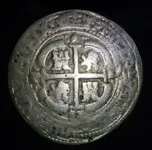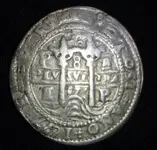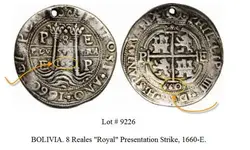DiveWrecks said:
I'm 99% certain this is a cast reproduction. It has no hard (hammered features) and that is not due to wear or corrosion necessarily, but is inherent in the casting process. There are also numerous pores, which aren't from corrosion or striking. The only cobs that were this perfectly round were royal presentation pieces. This i'm afraid, is not one.
Stan
To clarify (Stan knows this, he just didn't spell it out), it's actually a cast replica/fake OF a "Royal" Potosi round, 8 Reales (as in royal presentation piece). Frankly, the quality of this replica (lack thereof) is such that there shouldn't even be a discussion about it. In addition to (as mentioned) the numerous, obvious casting pores and the extreme "softness" in the detail, the design elements are crude such that it does not even appear to have been cast from an authentic specimen. This might make sense, of course... how many people who have authentic "Royals" are going about getting them cast? Probably not many.
The date, by the way, is clearly intended to be 1657, not 1677... the digits themselves between the pillars (657) and their STYLE should be quite certain to someone who is familiar with these. Also, the legend date, when the pic is rotated, clearly shows the "5" in "1657". Aside from that... um... "PHILIP...", clear as day in the legend.
On the topic of whether the dates between the pillars and under the cross appear in 2-digit or 3-digit form (speaking strictly about Potosi pieces here, though to my knowledge, most Lima issues follow the same pattern)... Firstly, on both regular-strike cobs and royals of all dates, the date in the legend is always given in four digit-form... so that's not an issue.
"Between pillars" date: Generally, on regular strike cobs, most were given as two digits during the 1600s, and as 3 digits ("7xx") during the 1700s. Some pillar dates in the early 1700s were still given as "two-digits", however most were now given using THREE digits... Anything you see from 1720 and up, however, will have always have 3. I can't think of any 1600s "Royal" pieces that aren't two-digit, either... While it is possible 1600s royals with 3 digits "could" have been produced, that would certainly be out of the ordinary.
"Under cross" date: On both regular-strike cobs and the royals that I've seen, from 1652 through much of the the 1660s, the date was often given as three digits "6xx". I've seen some with only 2 digits in these years... but more often than not, it's 3. From the 1670s through the 1690s, I can only recall ever seeing 2 digits... But then, at the turn of that century through the rest of the 1700s, the cross date was again given as three digits pretty much without exception.








